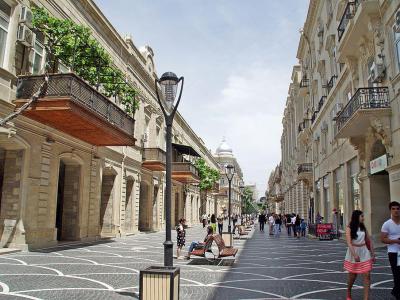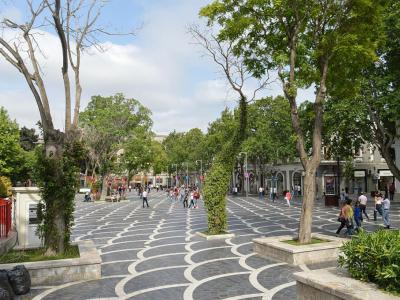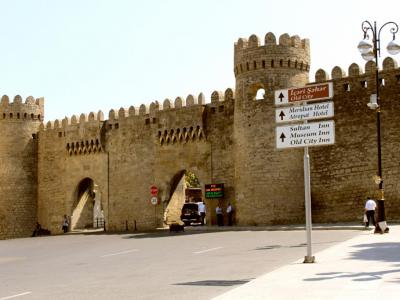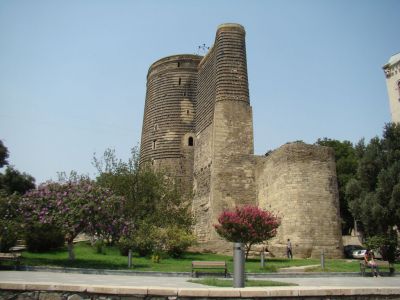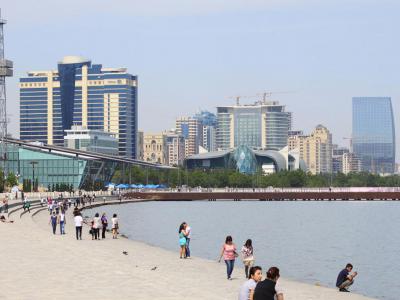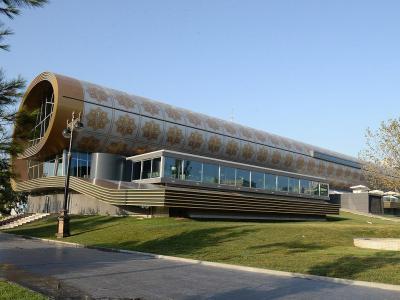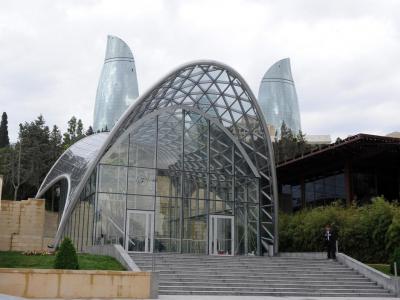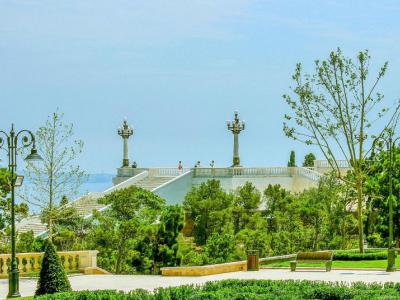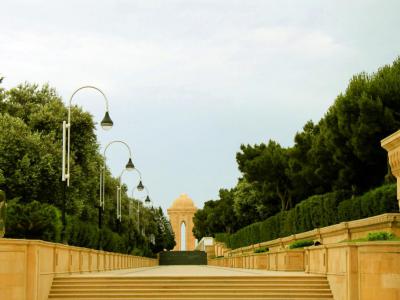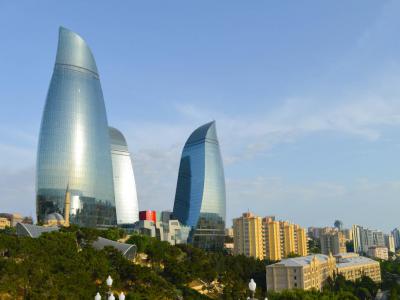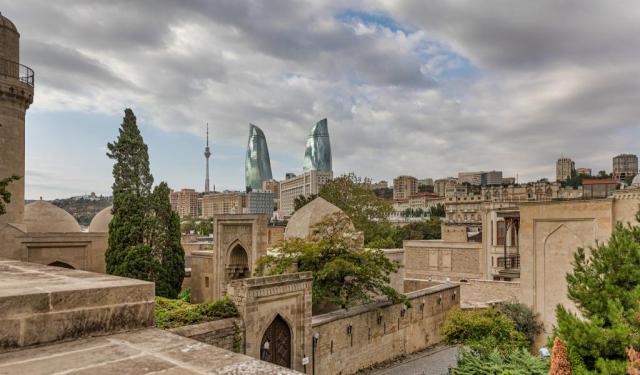Baku Introduction Walking Tour (Self Guided), Baku
Baku is the capital city of Azerbaijan. It is also the country's largest city with about 25 percent of the nation's population located here.
A city existed on the site of Baku since at least the 5th century ADE. The city at that time was called Bagavan. The first record of its modern name appeared in 938 when it was called Bakuh. The city was a domain of the Arab Caliphate, followed by the Shirvanshahs. Shirvanshah Akhsitan I built a navy in Bakuh to protect against invading forces, which was often successful.
The capital moved to Bakuh after an earthquake destroyed the previous capital of Shamakhy. As the country was occupied by various powers over the years, it remained the capital and most important city in the region.
Baku began seeing significant financial success in the 19th century when an oil boom brought massive growth. From the last half of the 19th century to about 1910, Baku grew faster than some of the world's greatest cities, like New York City, London and Paris.
The city fell under communist control in 1920, which would massively change its landscape and success. It remained a major producer of oil, but many of the most important architectural sites were altered or destroyed. Mosques were dismantled or used for other purposes, which was the case with Juma Mosque. It because the first home of the State Carpet Museum.
After the Soviet Union fell, Azerbaijan became an independent nation. Many of the Soviet-era buildings were taken down and replaced with parks, green space and other recreational areas. A prime example of this is Baku Boulevard, which is now a lush promenade adjacent to the Caspian Sea.
In the years since the Soviet Union fell, Baku's culture, technology and architecture have rapidly advanced. This can be best seen in the Flame Towers, which are three skyscrapers covered in LEDs that project stunning images across their facade.
Take this self-guided walking tour to see some of the most important and historic sights in Baku.
A city existed on the site of Baku since at least the 5th century ADE. The city at that time was called Bagavan. The first record of its modern name appeared in 938 when it was called Bakuh. The city was a domain of the Arab Caliphate, followed by the Shirvanshahs. Shirvanshah Akhsitan I built a navy in Bakuh to protect against invading forces, which was often successful.
The capital moved to Bakuh after an earthquake destroyed the previous capital of Shamakhy. As the country was occupied by various powers over the years, it remained the capital and most important city in the region.
Baku began seeing significant financial success in the 19th century when an oil boom brought massive growth. From the last half of the 19th century to about 1910, Baku grew faster than some of the world's greatest cities, like New York City, London and Paris.
The city fell under communist control in 1920, which would massively change its landscape and success. It remained a major producer of oil, but many of the most important architectural sites were altered or destroyed. Mosques were dismantled or used for other purposes, which was the case with Juma Mosque. It because the first home of the State Carpet Museum.
After the Soviet Union fell, Azerbaijan became an independent nation. Many of the Soviet-era buildings were taken down and replaced with parks, green space and other recreational areas. A prime example of this is Baku Boulevard, which is now a lush promenade adjacent to the Caspian Sea.
In the years since the Soviet Union fell, Baku's culture, technology and architecture have rapidly advanced. This can be best seen in the Flame Towers, which are three skyscrapers covered in LEDs that project stunning images across their facade.
Take this self-guided walking tour to see some of the most important and historic sights in Baku.
How it works: Download the app "GPSmyCity: Walks in 1K+ Cities" from Apple App Store or Google Play Store to your mobile phone or tablet. The app turns your mobile device into a personal tour guide and its built-in GPS navigation functions guide you from one tour stop to next. The app works offline, so no data plan is needed when traveling abroad.
Baku Introduction Walking Tour Map
Guide Name: Baku Introduction Walking Tour
Guide Location: Azerbaijan » Baku (See other walking tours in Baku)
Guide Type: Self-guided Walking Tour (Sightseeing)
# of Attractions: 10
Tour Duration: 2 Hour(s)
Travel Distance: 4.1 Km or 2.5 Miles
Author: ellen
Sight(s) Featured in This Guide:
Guide Location: Azerbaijan » Baku (See other walking tours in Baku)
Guide Type: Self-guided Walking Tour (Sightseeing)
# of Attractions: 10
Tour Duration: 2 Hour(s)
Travel Distance: 4.1 Km or 2.5 Miles
Author: ellen
Sight(s) Featured in This Guide:
- Nizami Street
- Fountains Square
- Paired Fortress Gates
- Maiden Tower
- Baku Boulevard
- State Carpet Museum
- Baku Funicular
- Dagustu Park (Upland Park)
- Martyrs' Lane
- Flame Towers
1) Nizami Street
Nizami Street is a major street in downtown Baku. The street was first formed in 1864 to create a thoroughfare from the mountains to the railroad bed. Today, it is mostly known to visitors for the small pedestrian-only stretch that runs from Fountains Square to Rashid Behbudov Street.
The street, named after Azerbaijani poet Nizami Ganjavi, is known as one of the most expensive streets in the Southeast Europe. It is home to numerous banks and embassies. It is also the location of a wide number of shops and boutiques.
The architecture of the street is varied as the town has grown and changed. Many of the buildings were erected in the late 19th century though modern and mid-century architecture is also peppered throughout Nizami Street. Most architecture on the street can be classified as Neo-Renaissance, Neo-Gothic, Neoclassicism, Neo-Moorish and Baroque.
Historical landmarks along Nizami Street include the Central Universal Magazine building, the Central Library, Saint Gregory the Illuminator's Church, the Azerbaijan State Theater of Young Spectators and many others.
The street, named after Azerbaijani poet Nizami Ganjavi, is known as one of the most expensive streets in the Southeast Europe. It is home to numerous banks and embassies. It is also the location of a wide number of shops and boutiques.
The architecture of the street is varied as the town has grown and changed. Many of the buildings were erected in the late 19th century though modern and mid-century architecture is also peppered throughout Nizami Street. Most architecture on the street can be classified as Neo-Renaissance, Neo-Gothic, Neoclassicism, Neo-Moorish and Baroque.
Historical landmarks along Nizami Street include the Central Universal Magazine building, the Central Library, Saint Gregory the Illuminator's Church, the Azerbaijan State Theater of Young Spectators and many others.
2) Fountains Square (must see)
Fountains Square is a square in the central part of downtown Baku. It is named after the many fountains that populate the area. It stretches from Istiglaliyyat Street to Nizami Street along the walls of Icheri Sheher.
The square often hosts community events and celebrations. However, Fountains Square is mostly known as a casual gathering place for both locals and visitors. The square itself offers an artistic, mosaic style walkway, numerous shade trees, a carousel and many fountains. There is also ample room to sit on benches located both in sunny spots and under the shade.
Public art is located throughout the square. Visitors will also find numerous boutiques, shops and eating areas. Both restaurants and food carts are open throughout the day and into the evening.
The square was formerly called Parapet, which is still the name most of the locals use when describing the location. The name was changed to Fountains Square in 2010 after its renovation.
The square often hosts community events and celebrations. However, Fountains Square is mostly known as a casual gathering place for both locals and visitors. The square itself offers an artistic, mosaic style walkway, numerous shade trees, a carousel and many fountains. There is also ample room to sit on benches located both in sunny spots and under the shade.
Public art is located throughout the square. Visitors will also find numerous boutiques, shops and eating areas. Both restaurants and food carts are open throughout the day and into the evening.
The square was formerly called Parapet, which is still the name most of the locals use when describing the location. The name was changed to Fountains Square in 2010 after its renovation.
3) Paired Fortress Gates
The Paired Fortress Gates of Baku, also known as the Gates of Shah Abbas or the Shamakhi Gates, are a historic architectural marvel in Azerbaijan. Situated in the northern wall of the ancient Baku Fortress, these gates serve as a testament to the city's rich history and strategic importance. Originating from the ancient caravan route from Shamakhi, these gates have been a key entry point to the fortress.
Construction of the first gate commenced in the 12th century, ordered by Manuchohr III during the initial phases of the fortress's construction. The second gate, known as the Gates of Zulfugar Khan, was added in the 17th century under the reign of Shah I Abbas by Zulfugar Khan. Remarkably, despite being constructed centuries apart, both gates share nearly identical dimensions and designs, reflecting the consistent architectural style maintained over the periods.
The gates were fortified with embrasures and battlements to protect against enemy attacks, demonstrating their strategic military importance. In 1796, a pivotal moment in their history occurred when Baku Khan Huseyngulu surrendered the fortress keys to the Russians. Subsequently, in 1883, the Gates of Zulfugar were moved to align with the Shamakhi Gate, completing the pairing in 1886.
Until the late 19th century, these gates remained the sole entrance and exit to the fortress. They have undergone several restoration phases: in 1864, during Soviet rule from 1952 to 1957, and most recently from 2018 to 2019, ensuring their preservation and continued prominence as a historical site.
Today, the Paired Fortress Gates are a major tourist attraction in Baku. Located adjacent to a tourist information center, they are part of a lively area, with a section of the adjacent wall often featuring artistic murals. The vicinity thrives with commercial activity, hosting a row of shops by day and numerous restaurants, enriching the cultural experience for visitors.
Construction of the first gate commenced in the 12th century, ordered by Manuchohr III during the initial phases of the fortress's construction. The second gate, known as the Gates of Zulfugar Khan, was added in the 17th century under the reign of Shah I Abbas by Zulfugar Khan. Remarkably, despite being constructed centuries apart, both gates share nearly identical dimensions and designs, reflecting the consistent architectural style maintained over the periods.
The gates were fortified with embrasures and battlements to protect against enemy attacks, demonstrating their strategic military importance. In 1796, a pivotal moment in their history occurred when Baku Khan Huseyngulu surrendered the fortress keys to the Russians. Subsequently, in 1883, the Gates of Zulfugar were moved to align with the Shamakhi Gate, completing the pairing in 1886.
Until the late 19th century, these gates remained the sole entrance and exit to the fortress. They have undergone several restoration phases: in 1864, during Soviet rule from 1952 to 1957, and most recently from 2018 to 2019, ensuring their preservation and continued prominence as a historical site.
Today, the Paired Fortress Gates are a major tourist attraction in Baku. Located adjacent to a tourist information center, they are part of a lively area, with a section of the adjacent wall often featuring artistic murals. The vicinity thrives with commercial activity, hosting a row of shops by day and numerous restaurants, enriching the cultural experience for visitors.
4) Maiden Tower (must see)
Maiden Tower is a tower in the Old City section of Baku. The 97-foot tower was completed in the 12th century. The tower is one of the most distinctive symbols of Azerbaijan and is featured on national emblems, letterheads and currency.
Archaeological and architectural evidence shows that the tower is an example of pre-Islamic architecture. It is believed that the Maiden Tower once had seven fire exits at its top, which would indicate it to be a Zoroastrian fire temple. Zoroastrianism is the ancient religion of Iran.
The foundation of the tower is much older than the tower itself. The underground foundation and the first three stories were built sometime between the 4th and 6th centuries. This also supports the idea that the tower was a Zoroastrian temple.
It is believed that the construction of the tower in the 12th century. It is also thought that the tower was then used as an astronomical observatory.
Maiden Tower was designated as a UNESCO World Heritage Site in 2000. Not long after this designation, an earthquake caused damage to the tower. Conservation efforts went into place to ensure the Maiden Tower remained structurally sound. A restoration plan was completed in 2013 in which the damaged sections were restored and plexiglass barriers were added to the observation deck.
Inside Maiden Tower is a museum that shows the history of Baku. Visitors can go to the observation deck to see a view of the city and Baku Bay.
Archaeological and architectural evidence shows that the tower is an example of pre-Islamic architecture. It is believed that the Maiden Tower once had seven fire exits at its top, which would indicate it to be a Zoroastrian fire temple. Zoroastrianism is the ancient religion of Iran.
The foundation of the tower is much older than the tower itself. The underground foundation and the first three stories were built sometime between the 4th and 6th centuries. This also supports the idea that the tower was a Zoroastrian temple.
It is believed that the construction of the tower in the 12th century. It is also thought that the tower was then used as an astronomical observatory.
Maiden Tower was designated as a UNESCO World Heritage Site in 2000. Not long after this designation, an earthquake caused damage to the tower. Conservation efforts went into place to ensure the Maiden Tower remained structurally sound. A restoration plan was completed in 2013 in which the damaged sections were restored and plexiglass barriers were added to the observation deck.
Inside Maiden Tower is a museum that shows the history of Baku. Visitors can go to the observation deck to see a view of the city and Baku Bay.
5) Baku Boulevard (must see)
Baku Boulevard is a promenade that was constructed in 1909. The park began as a horticultural program, which included the planting of trees and shrubs. It was then expanded in order to provide a recreational area for the growing city.
The original design for the park featured a bathing house, pavilions and a luxury restaurant. A casino designed by Polish architect Jozef Plosko was added in 1912.
The Soviet era brought many changes to Baku Boulevard. The bathing house closed due to pollution from the sea and lack of maintenance. The casino was converted to a puppet theatre. A parachute tower was built for adventure sports, but it was shut down and parachuting was banned after a fatality in the 1960s.
The boulevard was named a national park in 1999 by President Heydar Aliyev. Since then, the amusement park has added new rides, Parachute Tower was reconstructed, new public art was installed and a musical fountain was constructed. There is also a yacht club and a multi-story shopping mall with a 5D cinema.
Other spots of interest in and around Baku Boulevard include the Baku Ferris Wheel, the Azerbaijan Carpet Museum, the Stone Chronicle Museum, the Yarat Contemporary Art Center and an open-air cinema. Mini Venice is a popular attraction as well.
The park is regularly used for cultural gatherings, celebrations, parades and concerts. It has become the annual location of the city's New Year's Eve Party as well.
Baku Boulevard runs parallel to the Baku Bay shoreline of the Caspian Sea. It begins at Freedom Square and continues to National Flag Square.
The original design for the park featured a bathing house, pavilions and a luxury restaurant. A casino designed by Polish architect Jozef Plosko was added in 1912.
The Soviet era brought many changes to Baku Boulevard. The bathing house closed due to pollution from the sea and lack of maintenance. The casino was converted to a puppet theatre. A parachute tower was built for adventure sports, but it was shut down and parachuting was banned after a fatality in the 1960s.
The boulevard was named a national park in 1999 by President Heydar Aliyev. Since then, the amusement park has added new rides, Parachute Tower was reconstructed, new public art was installed and a musical fountain was constructed. There is also a yacht club and a multi-story shopping mall with a 5D cinema.
Other spots of interest in and around Baku Boulevard include the Baku Ferris Wheel, the Azerbaijan Carpet Museum, the Stone Chronicle Museum, the Yarat Contemporary Art Center and an open-air cinema. Mini Venice is a popular attraction as well.
The park is regularly used for cultural gatherings, celebrations, parades and concerts. It has become the annual location of the city's New Year's Eve Party as well.
Baku Boulevard runs parallel to the Baku Bay shoreline of the Caspian Sea. It begins at Freedom Square and continues to National Flag Square.
6) State Carpet Museum (must see)
The State Carpet Museum, also known as the Azerbaijan Carpet Museum, is a museum located in the Baku Boulevard promenade park. The museum displays Azerbaijani carpets and rugs. It was established in 1967.
The first State Carpet Museum opened on Neftcihler Avenue in a 15th century mosque. It moved to the second floor of the Baku Museum Center in 1992 in what had once been the Lenin museum.
The museum moved to its current home on the seafront in 2014. The building was designed by architect Franz Janz to have the appearance of a roll of carpet.
The State Carpet Museum holds the distinction of having the largest collection of Azerbaijani carpets and rugs in the world. It also holds a number of non-carpet exhibits. These include ceramics, jewelry, clothing items, embroidery and artworks.
Visitors to the museum can see live demonstrations of the weaving techniques used in traditional Azerbaijani rugs. There are also exhibits displaying the use of carpets and how they reflect on history. The museum also has an exhibit devoted to Latif Karimov, who was thought to be the authority on the art of carpet weaving.
The first State Carpet Museum opened on Neftcihler Avenue in a 15th century mosque. It moved to the second floor of the Baku Museum Center in 1992 in what had once been the Lenin museum.
The museum moved to its current home on the seafront in 2014. The building was designed by architect Franz Janz to have the appearance of a roll of carpet.
The State Carpet Museum holds the distinction of having the largest collection of Azerbaijani carpets and rugs in the world. It also holds a number of non-carpet exhibits. These include ceramics, jewelry, clothing items, embroidery and artworks.
Visitors to the museum can see live demonstrations of the weaving techniques used in traditional Azerbaijani rugs. There are also exhibits displaying the use of carpets and how they reflect on history. The museum also has an exhibit devoted to Latif Karimov, who was thought to be the authority on the art of carpet weaving.
7) Baku Funicular
The Baku Funicular is a funicular that connects Neftchilar Avenue to Martyrs' Lane. It has a 1,493-foot track with two coaches. The funicular transports about 2000 people per day. This is the only funicular in Azerbaijan.
The funicular was built under orders by Baku mayor Alish Lambaranski. Work on the funicular was completed in 1960 but required regular repairs. The funicular finally shut down in the 1980s due to lack of maintenance.
Repairs took place in 2001, which allowed the funicular to reopen. Yet another complete overhaul of the system occurred in 2012. It has been in continuous working order since the last redesign.
Riding the funicular gives tourists excellent views of the city. They can admire Baku Boulevard, the Flame Towers and the Caspian Sea from the comfort of the retro coach. The funicular runs daily from 10 AM to 10 PM with only a 10-minute wait between coaches.
The funicular was built under orders by Baku mayor Alish Lambaranski. Work on the funicular was completed in 1960 but required regular repairs. The funicular finally shut down in the 1980s due to lack of maintenance.
Repairs took place in 2001, which allowed the funicular to reopen. Yet another complete overhaul of the system occurred in 2012. It has been in continuous working order since the last redesign.
Riding the funicular gives tourists excellent views of the city. They can admire Baku Boulevard, the Flame Towers and the Caspian Sea from the comfort of the retro coach. The funicular runs daily from 10 AM to 10 PM with only a 10-minute wait between coaches.
8) Dagustu Park (Upland Park)
Dagustu Park is a large, wooded park in the midst of downtown Baku. Dagustu Park contains numerous shade trees and walking paths along with historical landmarks, a cemetery and a place of worship. It is arguably best known for having the highest point in Baku.
The panoramic view from the observation deck at Dagustu Park can be reached by the Baku Funicular. It offers an excellent opportunity to see the city and the Caspian Sea. Visitors can also see the Flame Towers and their motion displays from this vantage point.
Dagustu Park also offers an excellent restaurant with a live jazz band that plays in the evenings. The Shahidlar Monument is located within the park while the Hezi Aslanov Qebirustu Abidesi landmark rests nearby. Dagustu Fountain and the Baku British Military Memorial are both worth stopping to visit while strolling through this lovely green space.
The panoramic view from the observation deck at Dagustu Park can be reached by the Baku Funicular. It offers an excellent opportunity to see the city and the Caspian Sea. Visitors can also see the Flame Towers and their motion displays from this vantage point.
Dagustu Park also offers an excellent restaurant with a live jazz band that plays in the evenings. The Shahidlar Monument is located within the park while the Hezi Aslanov Qebirustu Abidesi landmark rests nearby. Dagustu Fountain and the Baku British Military Memorial are both worth stopping to visit while strolling through this lovely green space.
9) Martyrs' Lane
Martyrs' Lane is a cemetery located in Dagustu Park. It was established in 1990 for those killed during the Caucuses campaign, March Days, Black January and the First Nagorno-Karabakh War. There are approximately 15,000 interments in the cemetery.
The cemetery was originally the first Muslim cemetery for victims of fighting in Baku during the Russian Civil War. When the Bolsheviks came to power, the cemetery was destroyed and an amusement park was placed on the site. The cemetery was only reinstated after the collapse of the Soviet Union.
The cemetery is home to a memorial to the Turkish soldiers who were killed in combat. The large memorial honors 1,130 Turkish troops killed during the Battle of Baku in 1918. There is also a martyrs mosque that was unveiled in 1999.
The Eternal Flame Memorial Complex was erected in 1998. It is a tomb standing on an eight-pointed star crown inside a gold-framed glass dome.
Martyrs' Lane was previously known as the Kirov Park. It is sometimes referred to as "Alley of Martyrs."
The cemetery was originally the first Muslim cemetery for victims of fighting in Baku during the Russian Civil War. When the Bolsheviks came to power, the cemetery was destroyed and an amusement park was placed on the site. The cemetery was only reinstated after the collapse of the Soviet Union.
The cemetery is home to a memorial to the Turkish soldiers who were killed in combat. The large memorial honors 1,130 Turkish troops killed during the Battle of Baku in 1918. There is also a martyrs mosque that was unveiled in 1999.
The Eternal Flame Memorial Complex was erected in 1998. It is a tomb standing on an eight-pointed star crown inside a gold-framed glass dome.
Martyrs' Lane was previously known as the Kirov Park. It is sometimes referred to as "Alley of Martyrs."
10) Flame Towers (must see)
Flame Towers is a series of three skyscrapers that are occupied by office space, residential apartments, a hotel and a shopping mall. The towers were opened in 2013.
Flame Tower 1 is the tallest of the three at 597 feet. Flame Tower 2 is 541-feet tall and Flame Tower 3 rests at 528 feet. The three towers are meant to represent Azerbaijan's nickname, "The Land of Fire." The Azerbaijani nickname comes from its Zoroastrian roots in which flames were thought to be a symbol of divinity.
The towers are covered with LED screens that display light shows visible from throughout the city. The screens use over 10,000 LED luminaires. Light shows include the Azerbaijani flag, tanks of water being filled and giant flames. These light shows change every two minutes.
The towers are best viewed from the observation area of Dagustu Park. They are particularly lovely in the evening hours when the lights dominate the city skyline.
Flame Tower 1 is the tallest of the three at 597 feet. Flame Tower 2 is 541-feet tall and Flame Tower 3 rests at 528 feet. The three towers are meant to represent Azerbaijan's nickname, "The Land of Fire." The Azerbaijani nickname comes from its Zoroastrian roots in which flames were thought to be a symbol of divinity.
The towers are covered with LED screens that display light shows visible from throughout the city. The screens use over 10,000 LED luminaires. Light shows include the Azerbaijani flag, tanks of water being filled and giant flames. These light shows change every two minutes.
The towers are best viewed from the observation area of Dagustu Park. They are particularly lovely in the evening hours when the lights dominate the city skyline.
Walking Tours in Baku, Azerbaijan
Create Your Own Walk in Baku
Creating your own self-guided walk in Baku is easy and fun. Choose the city attractions that you want to see and a walk route map will be created just for you. You can even set your hotel as the start point of the walk.
Baku Old City Walking Tour
Baku's "Ichari Shahar" [pronounced ee-char-EE sha-HAR], which literally means Inner City, is also often referred to by foreigners as the Old City. This unique architectural preserve differs considerably from other ancient places in Azerbaijan and is replete with fascinating architectural monuments. The most prominent of them are the 12th-century, 97-foot Maiden Tower (the most... view more
Tour Duration: 1 Hour(s)
Travel Distance: 1.0 Km or 0.6 Miles
Tour Duration: 1 Hour(s)
Travel Distance: 1.0 Km or 0.6 Miles
Baku's Architectural Jewels
The city of Baku is an architectural marvel that delights with its historic buildings, grand mansions and cultural diversity. The Old City, for example, is full of fantastic old mosques and palaces that are listed as heritage monuments by UNESCO. The city is especially beautiful at night when it is wonderfully illuminated. Follow this self-guided walking tour to see the most impressive... view more
Tour Duration: 2 Hour(s)
Travel Distance: 3.8 Km or 2.4 Miles
Tour Duration: 2 Hour(s)
Travel Distance: 3.8 Km or 2.4 Miles
The Most Popular Cities
/ view all



